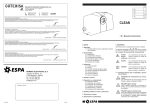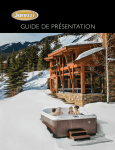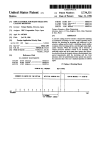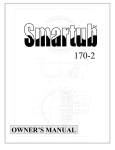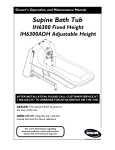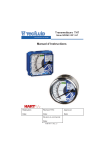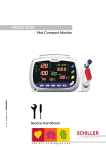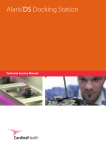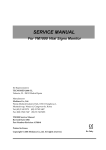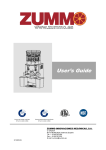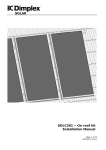Download kit de nage à contre-courant nage booster
Transcript
KIT DE NAGE À CONTRE-COURANT Instructions d’emploi et de maintenance NAGE BOOSTER F 0. TABLE DES MATIÈRES. 1. SÉCURITÉ. 1. Sécurité. 1.1. Conseils de base pour la sécurité et la prévention de dommages. Avertissement pour la sécurité des personnes et des objets. 2. Généralités. 2.1. Introduction. 2.2. Fonctions principales. 2.3. Caractéristiques techniques. 2.4. Composants principaux. 3. Installation. 3.1. Piscines en structure panneau. 3.2. Piscines en polyester. 3.3. Piscines en maçonnerie. 3.4. Montage de la plaque frontale. 3.5. Montage du tuyau d’air. 3.6. Montage de l’interrupteur de pression. 3.7. Montage de la pompe. 3.8. Mise en marche. 4. Mode d’emploi. 4.1. Marche/Arrêt de la pompe. 4.2. Régulateur d’air. 4.3. Régulateur de débit. 5. Réparation et maintenance. 5.1. Généralités. 5.2. Hivernage. 6. Problèmes possibles, causes et solutions. 7. Dimensions et poids. 8. Déclaration de conformité. 36 Manuel d’instructions Les symboles suivants accompagnant un paragraphe indiquent la possibilité d’un danger si les recommandations suivantes ne sont pas respectées. DANGER La non observation de cette risque précaution peut entraîner un risque d'électrocution d’électrocution. DANGER La non observation de cette précaution peut entraîner un risque de lésion pour les personnes. ATTENTION La non observation de cette précaution peut endommager l’appareil ou l’installation. 1.1. Conseils de base pour la sécurité et la prévention de dommages. ATTENTION lire attentivement les instructions. Lire attentivement les instructions (14) avant d’installer ou d’utiliser cet appareil. MANUEL D’INSTRUCTIONS F 2. GÉNÉRALITÉS. DANGER risque d’électrocution. Prendre toutes les précautions nécessaires en manipulant l’appareil, car il est branché sur le secteur et contient de l’eau (très bonne conductrice d’électricité). Avant toute intervention sur la pompe, il faut la débrancher du secteur. INSTRUCTION MANUAL GB 7. DIMENSIONS AND WEIGHTS. 2.1. Introduction. L’unité de nage à contre-courant est un appareil pour piscines permettant d’obtenir un courant d’eau au travers d’une électropompe. Il est à employer principalement pour la pratique de la nage à contre-courant. DANGER câble d’alimentation. Installer le câble d’alimentation de manière à éviter de marcher dessus, de le perforer ou de l’endommager avec un objet situé dans les environs. En option, avec un tuyau de massage (non fourni), il peut diffuser des milliers de petites bulles procurant à l’utilisateur les bienfaits d’un massage aux effets hydrothérapeutiques. Il est disponible avec une plaque au design rond ou carré et peut également disposer d’un accessoire de coffret mural de commande de la pompe en trois versions selon l’alimentation ou la puissance de l’électropompe à installer. Pour l’installation, suivre les indications de sécurité pour piscines et les indications particulières de la pompe à installer (non fournie avec l’appareil). Pour l’installation de l’appareil, il faut respecter les normes de sécurité en vigueur. 2.2. Fonctions principales. INTERDICTION de manipuler ou de réparer. Les manipulations ou les réparations ne doivent être effectuées que par des services techniques officiels. L’utilisateur ne devra faire que les manipulations indiquées dans le manuel. Le fabricant décline toute responsabilité en cas de manipulations non indiquées effectuées par l’utilisateur. MODEL b) Blower : il comprend le contrôle de bulles par l’étranglement du passage de l’air qui, par un effet venturi, est diffusé simultanément avec le jet d’eau. KIT NCR X KIT NCRM X KIT NCRT1 X KIT NCRT2 X c) Interrupteur de Marche/Arrêt Pompe : pour la sécurité électrique, il dispose d’un bouton pneumatique qui commande à distance l’interrupteur pneumatique du coffret de commande. Pour mettre en marche ou arrêter l’électropompe. ATTENTION nettoyage. Toujours nettoyer avec un chiffon humide et une solution de savon neutre. Ne pas utiliser de produits contenant des dissolvants ou des acides. 2.3. Caractéristiques techniques. Débit maximum admissible 80 m3/h Débit minimum recommandé 40 m3/h Connexions hydrauliques Ne pas laisser fonctionner la pompe à vide, l’eau de la piscine doit recouvrir toute la façade. Connexions électriques CONTROL CABINET PLATE a) Hydrojet : il comprend la fonction de réglage manuel du débit et l’orientation du jet d’eau. ROUND 1~ 230V <2,2kW SQUARE X X KIT NCC X KIT NCCM X KIT NCCT1 X KIT NCCT2 X X X X Ø 63 intérieur NC_M 1 ~ 230 V NC_M 16A NC_T1 6.3A NC_T2 10A 2 35 A WEIGHT (Kg) 314 4 314 4.7 314 4.7 314 4.7 3kW X NC_T_ 3 ~ 400 V Intensité maximale admissible 3~ 400V 340 4 340 4.7 340 4.7 340 4.7 INSTRUCTION MANUAL GB MANUEL D’INSTRUCTIONS F 6. POSSIBLE PROBLEMS, CAUSES AND SOLUTIONS. 2.4. Composants principaux. PROBLEMS – Water flow is insufficient SOLUTIONS CAUSES – Recirculation of water. – Maximum flow of the pump is small. 1 – Check correct fitting of components, and particularly that the gasket has been fitted. – Check correct pump dimensioning. 2 x3 – No air bubbles emerge – The pump does not start – The filter (9) fitted in the hose is dirty and air does not pass. – Air passage at the front plate (6) is obstructed by insects or foreign bodies. – The air regulator is closed. – Clean the filter (9) and remove impurities. – The capillary pipe (7) is disconnected or has leaks. – There is no electricity supply to the installation. – Incorrect pressure microswitch operation. – Check that the capillary pipe (7) is correctly installed. – The pump thermal cut-out switch activates. – The motor-protection cut-out on the panel throws. – The installation’s differential circuitbreaker switch triggers – Electrical connection failure. – Check that the premises is correctly ventilated and that air passage of the pump fan is not obstructed. – Check that the pump ampere rating is less than or equal to the cut-out trigger rating. – Check for insulation or shunt-off faults. – The pump is not primed. – The suction pipes are not sealed and the pump takes in air. – The suction piping is long and the pump is higher than the swimming pool level. – Pool water level insufficient and air is being taken in. – Fill the suction body up to the level of the suction connection. – Repair leaks. – Bleed air from the pump. – A check valve without spring pressure must be mounted in the suction pipes to prevent water draining during suction. – Condenser defective. – Check that the condenser is of the correct capacity. – Replace if faulty. – The motor shaft must rotate slightly. – If not, the pump must be repaired by the technical service centre. – Clean and ensure that air is passing to the discharge pipe. 3 – When the air regulator is opened bubbles should emerge. 4 5 – Wait for electricity supply to be restored. – Check electrical continuity at the pressure switch by activating and deactivating the button. 7 – The pump stops running – The pump does not take in water – The motor protection switch triggers – Noise. – Pump blocked by obstruction of the turbine. – Air is entering the equipment. – Noise from bearings. – Foreign bodies in the pump. 6 – Check that electrical connections are correct. 8 * 9 x2 – Raise the water level of the pool to at least 10 cm above the plate. 14 10 x2 – Stop leaks. – The pump must be repaired by the technical service centre. – Remove them as explained in the pump maintenance manual. 34 11 x12 1 2 3 4 5 6 7 8 9 10 11 12 13 14 15 PIÈCE/MODÈLE Contrebride fixation Joint mousse Corps arrière Plaque de protection Bride fixation Facade Tube capillaire Coffret électrique (optionnel)* Filtre mousse Clip fixation Vis DIN7982 Ø 4,8 x 45 Vis DIN965 M 5 x 30 Vis DIN DIN7982 Ø 5,5 x 16 Manuel d’instructions Gabarit 12 x3 13 x2 15 3 MANUEL D’INSTRUCTIONS F INSTRUCTION MANUAL 3. INSTALLATION. 5. REPAIR AND MAINTENANCE. Selon le type de construction de la piscine. 5.1. General considerations. GB Check the air-passage filter (9) and if necessary clean out any dirt or insects. 3.1. Piscines en structure panneau. 5.2. Overwintering. a) Découpe du panneau. Séparer la toile du panneau. The installation must be protected in winter against the potential risk of freezing. The following operations will have to be carried out: A Poser le gabarit (15) sur la partie intérieure du panneau de la piscine en faisant en sorte que la distance entre la ligne XY et la hauteur maximale de la structure soit de 400 mm. La ligne XY doit être parallèle à la ligne de hauteur maximale de la piscine. – Disconnect the pump from the electricity supply. X Y B – Remove the front plate (6) and the capillary pipe (7) of the pressure switch and stow them away. – Drain the water from inside the pump, using the drain plug. – Fit the protective cover (4). Marquer les 14 trous de montage et découper la zone en pointillés du modèle pour pouvoir dessiner les contours de découpe sur le panneau. Découper au contour et percer les trous marqués sur le panneau. Partie intérieure de la piscine Prendre soin de ne pas déchirer la toile. b) Montage préalable, avec la toile séparée du panneau et selon le dessin. A Nettoyer les surfaces de contact entre les joints (2), le corps arrière (3) et la contrebride (1) et le panneau de la piscine. A. – Coller un joint (2) sur la contrebride (1). B. – Coller les deux joints (2) restants sur le corps arrière (3) (selon le dessin). B After the overwintering period refit the components removed and, before running the pump: – Check manually to ensure that the pump motor shaft rotates, by rotating the fan. – Check the connections for leaktightness. Correct operation of the installation must be checked during the first few minutes of running. 4 33 INSTRUCTION MANUAL GB 3.8. Start-up. Once the connections have been made and before running the pump the leaktightness of joints must be checked. Switch on the water supply to the pump and eliminate any air left inside the pump by using the bleed devices on the pump. Start up the pump. Press “Start” on the electrical panel (8) and press the pneumatic pump-start button. The pipe valves must be fully open during pump operation and must never be closed while it is running. Shutting off or quickly reducing the passage of water can give rise to pressure surges that could lead to equipment breakage. MANUEL D’INSTRUCTIONS F C. – Fixer la contrebride (1) sur la partie arrière du panneau de la piscine, poser le corps arrière (3) de l’autre côté du panneau et le fixer fermement à sa place tout en vissant les 2 vis (13) dans les trous A et B. C D. S’assurer que le corps arrière (3) est en position correcte. Le mot “HAUT” doit se trouver sur la partie supérieure. A Leave the pump running for a few minutes and check that the equipment has been correctly installed. D B 4. INSTRUCTIONS FOR USE. 4.1. Starting / Stopping the pump. Keep air passage closed if the massage hose is not in use. The pump will come into operation when the pneumatic pushbutton is pressed, and will stop if it is pressed again. Note: The hydromassage hose is an accessory not supplied with the equipment. 4.3. Flow regulator. The water flow can be adjusted by turning the discharge pipe to the right or to the left. The direction of the water jet can also be adjusted using the discharge pipe knuckle-joint system. A c) Montage. Après avoir posé le liner, remplir la piscine d’eau, environ 15 cm, pour bien le tendre. A. – Poser la bride (5) sur la toile, en cherchant la position et en profitant du saillant de la plaque de protection (4) pour la positionner. Introduire les vis (11) en perçant la toile et visser à fond. Il faut éviter de trop serrer les vis. B. – Après avoir fixé toutes les vis, découper la partie intérieure du liner avec un cutter. 4.2. Air regulator. C. – Retirer la plaque de protection (4) et la ranger. With the hydromassage hose connected, turn the regulating button to regulate the air bubbles. B Maximum 32 Medium FLOW C Minimum 5 MANUEL D’INSTRUCTIONS INSTRUCTION MANUAL F 3.2. Piscines en polyester. GB c) Electrical wiring. a) Découpe du panneau. Installation and assembly must be entrusted to an authorised installer. The wiring must be in accordance with EEC standard or of type H07 RN-F according to VDE 0250. Poser le gabarit (15) sur la partie intérieure du panneau de la piscine, de manière à ce que la distance entre la ligne XY et la hauteur maximale de la structure soit de 400 mm. La ligne XY doit être parallèle à la ligne de hauteur maximale de la piscine. The electrical trunking must be watertight, and connections and their fittings must have a sufficient degree of protection against vertical fall of water drops. Connections, trunks and branch connections must always be housed in leaktight boxes. A X Marquer les 14 trous de montage et découper la zone en pointillés du modèle, pour pouvoir dessiner les contours de découpe sur le panneau. Y B Découper au contour et percer les trous marqués sur le panneau. Wiring diagram Partie intérieure de la piscine b) Montage préalable, selon le dessin : Nettoyer les surfaces de contact entre les joints (2), le corps arrière (3) et la contrebride (1) et le panneau de la piscine. A B A. – Coller un joint (2) sur la contrebride (1). B. – Coller un joint (2) sur le corps arrière (3). Single-phase control cabinet Three-phase control cabinet C C. – Fixer la contrebride (1) sur la partie arrière du panneau de la piscine, poser le corps arrière (3) de l’autre côté du panneau et le fixer fermement à sa place tout en vissant les 2 vis (13) dans les trous A et B. A B 6 31 INSTRUCTION MANUAL GB 3.7. Fitting the pump. MANUEL D’INSTRUCTIONS F D. - S’assurer que le corps arrière (3) est en position correcte. Le mot “HAUT” doit se trouver sur la partie supérieure. Pump installation and assembly must be carried out by an authorised installer. D a) General safety warnings. Particular care must be paid to ensure that water cannot enter the pump motor or other electrically powered parts of the installation. The equipment must be fitted following current safety regulations for installing swimming pools, and particularly standard IEC 60364-7702 and the special regulations for each application. The premises in which the pump is installed must comply with the complementary technical safety instructions applicable to damp or wet premises. The pump must be installed on a flat surface and attached to the floor. To ensure the safety of persons, the pump must be installed at least 3.5 metres from the swimming pool. The premises must be provided with a drain that allows water to be evacuated in the event of flooding of the premises that might be detrimental to electrical safety and cause injury to persons. The mains electricity supply must be protected by an automatic power-supply cut-out device, a residual current circuit-breaker switch (∆fn) not exceeding 30 mA. For optimum pump operation and reliability the premises must be provided with a ventilation inlet. c) Montage. A. – Coller le joint (2) sur la bride (5). B. – Poser la bride (5) sur le corps arrière (3). Introduire les vis (11) jusqu’au fond. Il faut éviter de trop serrer les vis. C. – Retirer la plaque de protection (4) et la ranger. A b) Fitting the pipes. The connection pipes to the pump for distances of up to 3.5 metres must have a minimum diameter of DN63. For distances of up to 5 metres from the swimming pool piping of DN75 must be used, and DN90 piping for distances of more than 5 metres. The installation pipes and accessories must be made of PVC. Under no circumstances must iron pipes or accessories be used, as they could damage the plastic components of the installation. B Flow valves must be fitted in the discharge and suction pipes, so that the pump can be removed for maintenance without draining the swimming pool. Flow valves C 30 7 MANUEL D’INSTRUCTIONS F INSTRUCTION MANUAL GB 3.3. Piscines en maçonnerie. 3.5. Fitting the air hose Poser le gabarit (15) sur la partie intérieure du coffrage de la piscine de manière à ce que la distance entre la ligne XY et la hauteur maximale de la structure soit de 400 mm. La ligne XY doit être parallèle à la ligne de hauteur maximale de la piscine. A. The hose must be attached to the wall to form an air trap, or at a level above the maximum height of the swimming pool, so as to avoid emptying the pool. Alternatively, it can be attached to the wall at a height between the waterline and the maximum height of the pool. Use a securing staple (10) to ensure correct fitting. A B. Mount the filter (9) on the end of the hose in order to prevent dirt entering. X A Y Marquer et percer sur le panneau du coffrage les trous A et B. B Partie intérieure de la piscine B b) Montage. A. – Nettoyer le côté à adhérer de la contrebride (1) et ensuite fixer le joint (2). B. – Monter le corps arrière (3) sur la contrebride (1) et fixer l’ensemble à la structure du coffrage avec deux vis (DIN7982. Ø 5,5) dans les positions A et B, ces vis devant être fournies par l’installateur en fonction de l’épaisseur du panneau de coffrage. C. – S’assurer que le corps arrière (3) est en position correcte. Le mot « HAUT » doit se trouver sur la partie supérieure. 3.6. Fitting the pressure switch. A. The hose must be attached to the wall to form an air trap, or at a level above the maximum height of the swimming pool, so as to avoid emptying the pool. Use a securing staple (10) to ensure correct fitting. A B B. Cut the hose to the right length to reach the panel (8) and mount the filter (9) on the end of the hose in order to prevent dirt entering. The maximum length to ensure correct operation of the pressure switch is 25 metres. It is advisable to cut the capillary pipe to just the right length to reach the panel (8), ensuring that the connecting pipe is passed through again. C. Connect the capillary pipe (7) to the pressure switch, ensuring that it is firmly connected. A A B C B C 8 29 INSTRUCTION MANUAL GB 3.4. Fitting front plate. Pass the capillary pipe (7) through the hole in the rear body (3) until it emerges from the end of the hose on the side of the connections to the pump. Fit the capillary pipe (7) by pressing it into the pressure switch and ensuring that it is securely connected. Offer the front plate (6) up to the rear body (3), ensuring that the rubber gasket is in place before fixing the unit with the 3 M5 screws (12). MANUEL D’INSTRUCTIONS F Il faut faire en sorte d’éviter le passage de ciment entre le panneau du coffrage et le corps arrière (3) ; si besoin est, mettre entre les deux une plaque de polystyrène pour boucher les rainures éventuelles. Si la largeur du coffrage est plus grande que la largeur des manchons de branchement, fixer et coller les tuyaux d’entrée et de sortie d’eau correspondants. Les tuyaux de sortie pour la commande de l’interrupteur pneumatique et de l’entrée d’air doivent traverser le panneau de coffrage. Ces tuyaux sont pourvus d’une gaine ondulée pour éviter l’adhérence du ciment sur les tuyaux. Vue supérieure: A Tuyaux d’entrée et de sortie d’eau D. – Coller le joint (2) sur la bride (5). B E. – Après avoir retiré le coffrage, poser la bride (5) sur le corps arrière (3) face aux 12 trous. Introduire les vis (11). Il faut éviter de trop serrer les vis. F. – Retirer la plaque de protection (4) et la ranger. D Rubber gasket E F 28 9 MANUEL D’INSTRUCTIONS INSTRUCTION MANUAL F 3.4. Montage plaque frontale. GB Care must be taken to ensure that no cement passes between the formwork board and the rear body (3), if necessary placing a sheet of polystyrene between them to cover up any grooves. Faire passer le tube capillaire (7) dans le trou du corps arrière (3) jusqu’à ce qu’il sorte au bout du tuyau du côté des connexions à la pompe. Monter à pression le tube capillaire (7) sur l’interrupteur de pression assurant la connexion et poser la plaque frontale (6) sur le corps arrière (3) en prenant soin d’éviter d’endommager le joint en caoutchouc avant de fixer l’ensemble avec les 3 vis M5 (12). If the width of the formwork exceeds the width of the connecting hoses, attach and glue in place the corresponding water inlet and outlet pipes. The outlet pipes for pneumatic switch and air inlet control must pass through the formwork board. These pipes are housed inside a corrugated casing to prevent cement adhering to the pipes. Upper view: A Water inlet and outlet pipes D. Attach the gasket (2) to the flange (5). B E. Once the formwork has been removed, locate the flange (5) on the rear body (3) in alignment with the 12 holes. Insert the screws (11). Avoid the use of excessive force when driving home the screws. F. Withdraw the protective plate (4) and keep it safely. D Joint en caoutchouc E F 10 27 INSTRUCTION MANUAL GB MANUEL D’INSTRUCTIONS F 3.3. Masonry swimming pools. 3.5. Montage du tuyau d’air. a) Preparatory work. A. – Le tuyau doit être fixé au mur en faisant siphon ou être fixé à la sortie sur un niveau supérieur à la hauteur maximale de la piscine de manière à éviter le vidage de la piscine. Ou bien, le tuyau doit être fixé au mur entre le niveau de l’eau et la hauteur maximale de la piscine. Utiliser un clip (10) de fixation pour assurer le montage. Place the template (15) on the interior part of the swimming pool formwork, such that the distance between the plane XY and the maximum height of the structure is 400 mm. The plane XY must be parallel to the maximum-height plane of the swimming pool. A B. – Au bout du tuyau, monter le filtre (9) pour éviter l’entrée de saletés. A X Y Mark out and drill holes A and B in the formwork board. B Interior part of the swimming pool B b) Assembly. A. Clean the gluing side of the counterflange (1), then attach the gasket (2). B. Mount the rear body (3) on the counterflange (1) and attach the assembly onto the formwork structure using two screws (DIN 7982, Ø 5.5) in positions A and B, to be provided by the installer and depending on the thickness of the formwork board. C. Ensure that the rear body (3) is in the correct position. The work “HAUT” must be at the top part. 3.6. Montage de l’interrupteur de pression. A. – Le tuyau doit être fixé au mur en faisant siphon ou être fixé à la sortie sur un niveau supérieur à la hauteur maximale de la piscine de manière à éviter le vidage de la piscine. Utiliser un clip (10) de fixation pour assurer le montage. A B B. – Couper le tuyau à la dimension exacte pour arriver jusqu’au coffret (8) et monter le filtre (9) au bout du tuyau pour éviter l’entrée de saletés. La longueur maximale pour assurer le fonctionnement correct de l’interrupteur de pression est de 25 mètres. Il est conseillé de couper le tube capillaire à la dimension exacte pour arriver jusqu’au coffret (8). Ne pas oublier de réinstaller le tuyau de connexion. C. – Brancher le tube capillaire (7) sur l’interrupteur de pression assurant la connexion. A A B C B C 26 11 MANUEL D’INSTRUCTIONS INSTRUCTION MANUAL F 3.7. Montage de la pompe GB D. Ensure that the rear body (3) is in correct position. The word “HAUT” must be at the top part. D L’installation et le montage de la pompe doivent être réalisés par un installateur agréé. a) Prescriptions générales de sécurité. Il faut faire en sorte d’éviter qu’il puisse entrer de l’eau dans le moteur de la pompe ou dans d’autres parties électriques sous tension de l’installation. L’appareil doit être monté aux normes de sécurité en vigueur pour l’installation de piscines et en particulier à la norme IEC 60364-7702 et aux normes particulières à chaque application. Le local où est installée la pompe doit respecter les instructions techniques complémentaires de sécurité applicables pour les conditions de locaux humides ou mouillés. La pompe doit être installée sur un endroit plat en la fixant sur le sol. c) Assembly. Pour la sécurité des personnes, il faut installer la pompe à une distance d’au moins 3,5 m de la piscine. Le local doit être pourvu d’un écoulement d’eau permettant l’évacuation d’eau en cas d’inondation, pour une meilleure sécurité électrique et pour éviter tout risque de lésion sur les personnes. En cas d’installation dans un regard contigu au bassin, se référer à la norme française en viguer. Le local doit être pourvu d’une entrée de ventilation pour un excellent fonctionnement et une bonne fiabilité de la pompe. Le secteur d’alimentation électrique doit être protégé par un dispositif de coupure automatique de l’alimentation, un disjoncteur différentiel à courant résiduel (∆fn) ne dépassant pas 30 mA. A. Stick the gasket (2) to the flange (5). B. Place the flange (5) on the rear body (3). Drive the screws (11) fully home. Avoid excessive force when driving home the screws. C. Withdraw the protective plate (4) and stow it safely. A b) Montage des tuyauteries. Les tuyauteries de connexion à la pompe pour des distances de jusqu’à 3,5 m doivent avoir un diamètre minimum de DN63. Pour des distances de jusqu’à 5 m de la piscine, il faut utiliser une tuyauterie de DN75 ; à partir de 5 m, utiliser une tuyauterie de DN90. Les tuyauteries et les accessoires de l’installation doivent être en PVC, il ne faut en aucun cas utiliser d’accessoires ou de tuyauteries en fer car ils pourraient endommager les composants plastiques de l’installation. B Il faut monter deux vannes d’isolement sur les tuyauteries de refoulement et d’aspiration, afin de permettre le démontage de la pompe pour sa maintenance sans avoir à vider la piscine. C Vannes d'isolement 12 25 INSTRUCTION MANUAL GB 3.2. Polyester swimming pools. MANUEL D’INSTRUCTIONS F c) Branchement électrique. a) Cutting the panel. Le câblage doit correspondre à la norme CEE ou bien au type H07 RN-F selon VDE 0250. Place the template (15) on the interior part of the swimming pool panel, such that the distance between the plane XY and the maximum height of the structure is 400 mm. The plane XY must be parallel to the maximum-height plane of the swimming pool. L’installation et le montage doivent être effectués par un installateur agréé. A Les canalisations électriques doivent être étanches, les connexions et leurs appareillages doivent présenter le degré de protection correspondant à la chute verticale de gouttes d’eau. Les connexions, les raccordements et les dérivations doivent toujours être réalisés à l’intérieur de coffrets étanches. X Y Mark the 14 assembly holes and cut along the dottedline zone of the template so as to mark the cut outline on the panel. B Cut the outline and drill the holes marked in the panel. Schéma de branchements Interior part of the swimming pool b) Pre-assembly, according to the drawing: Clean the contact surfaces between the gaskets (2), rear body (3) and counterflange (1) and the panel of the swimming pool. A B A. Stick a gasket (2) onto the counterflange (1). B. Stick a gasket (2) onto the rear body (3). C. Secure the counterflange (1) through the rear part of the swimming pool panel, fit the rear body (3) from the other side of the panel and hold it firmly in place while the two screws (13) are driven into the holes A and B. C Coffret commande monophasée Coffret commande triphasée A B 24 13 MANUEL D’INSTRUCTIONS F 3.8. Mise en marche. Après avoir réalisé les branchements et avant de mettre en marche la pompe, il faut vérifier l’étanchéité des unions. Ouvrir le passage d’eau à la pompe et éliminer les restes d’air à l’intérieur de la pompe à l’aide des purgeurs disponibles sur la pompe. Mettre la pompe en marche : appuyer sur « Start » sur le coffret électrique (8) et actionner le bouton pneumatique de marche de la pompe. INSTRUCTION MANUAL GB C. Secure the counterflange (1) through the rear part of the swimming pool panel, fit the rear body (3) from the other side of the panel and hold it firmly in place while the two screws (13) are driven into the holes A and B. C D. Ensure that the rear body (3) is in correct position. The word “HAUT” must be at the top part. A Durant le fonctionnement de la pompe, les vannes de la tuyauterie doivent être complètement ouverts. Il ne faut jamais fermer les vannes durant le fonctionnement de la pompe : la fermeture ou la réduction rapide du passage de l’eau peut provoquer des coups de pression capables d’entraîner la rupture des appareils. D Maintenir la pompe en marche quelques minutes et vérifier l’installation correcte de l’appareil. B 4. MODE D’EMPLOI. 4.1. Marche/Arrêt de la pompe. Fermer le passage d’air quand on n’utilise pas le tuyau de massage. En appuyant sur le bouton pneumatique, la pompe se met en marche. Si on appuie de nouveau sur le bouton, la pompe s’arrête. Remarque : le tuyau d’hydromassage est un accessoire non fourni avec l’appareil. 4.3. Régulateur de débit. c) Assembly. On peut régler le débit d’eau en tournant à droite ou à gauche la base de l’hydrojet. After fitting the canvas, fill the swimming pool with approximately 15 cm of water so that it is well tensioned. On peut également diriger le jet d’eau grâce au système de rotule de la base. A A. Place the flange (5) on the canvas, seeking out the right position and making use of the lip of the protective plate (4) to position it. Insert the screws (11) so that they pierce the canvas and then drive them fully home. Avoid excessive force when driving home the screws. B. Once all the screws are secured, cut the interior part of the canvas with a cutter. C. Remove the protective plate (4) and stow it safely. 4.2. Régulateur d’air. Quand le tuyau d’hydromassage est connecté, tourner le bouton régulateur pour régler les bulles d’air. B Maximum 14 Moyen DÉBIT C Minimum 23 INSTRUCTION MANUAL GB 3. INSTALLATION. MANUEL D’INSTRUCTIONS F 5. RÉPARATION ET MAINTENANCE. According to swimming pool construction type. 5.1. Généralités. Vérifier et, si nécessaire, nettoyer les saletés ou les insectes se trouvant dans le filtre (9) de passage d’air. 3.1. Panel-structure swimming pools. a) Cutting the panel. A Remove the canvas from the panel. 5.2. Hivernage. L’installation doit être protégée en hiver contre tout risque de gelées. Il faut réaliser les opérations suivantes : X Place the template (15) on the interior part of the swimming pool panel, such that the distance between the plane XY and the maximum height of the structure is 400 mm. The plane XY must be parallel to the maximum-height plane of the swimming pool. Y B – Débrancher la pompe de l’alimentation électrique. – Démonter la plaque frontale (6) et le tube capillaire (7) de l’interrupteur de pression et les ranger. – Vider l’eau de l’intérieur de la pompe à l’aide du bouchon de purge. – Poser le couvercle de protection (4). Mark the 14 assembly holes and cut along the dottedline zone of the template so as to mark the cut outline on the panel. Cut the outline and drill the holes marked on the panel. Take care not to damage the canvas. Interior part of the swimming pool b) Pre-assembly, with the canvas removed from the panel and according to the drawing: A Clean the contact surfaces between the gaskets (2), rear body (3) and counterflange (1) and the panel of the swimming pool. A. Stick a gasket (2) onto the counterflange (1). B. Stick the remaining two gaskets (2) onto the rear body (3) (according to drawing). B Après la période d’hivernage, remonter les composants démontés et avant de mettre en marche la pompe : – Vérifier à la main si l’arbre moteur de la pompe tourne, en faisant tourner le ventilateur. – Vérifier l’étanchéité des connexions. Durant les premières minutes de fonctionnement, il faut contrôler le fonctionnement correct de l’installation. 22 15 MANUEL D’INSTRUCTIONS INSTRUCTION MANUAL F GB 6. PROBLÈMES POSSIBLES, CAUSES ET SOLUTIONS. 2.4. Main components. PROBLÈMES SOLUTIONS CAUSES – Le débit d’eau est insuffisant. – Recirculation d’eau. – Le débit maximum de la pompe est faible. – Vérifier le montage correct des composants et en particulier la présence du joint. – Vérifier le dimensionnement correct de la pompe. – Les bulles d’air ne sortent pas. – Le filtre (9) monté sur le tuyau est sale et l’air ne passe pas. – Le passage de l’air dans la plaque frontale (6) est bouché par des insectes ou des objets étrangers. – Le régulateur d’air est fermé. – Nettoyer le filtre (9) et éliminer les saletés. – Le tube capillaire (7) est débranché ou a des fuites. – Il y a une coupure de courant dans l’installation. – Fonctionnement de l’interrupteur de pression incorrect. – Vérifier l’installation correcte du tube capillaire (7). 1 2 x3 – La pompe ne démarre pas. – Nettoyer et assurer le passage de l’air vers le blower. 3 – En ouvrant le régulateur d’air, les bulles devraient sortir. 4 5 – Attendre le retour du courant électrique. – Vérifier la continuité électrique de l’interrupteur de pression, en activant et en désactivant le bouton. 7 – La protection thermique de la pompe saute. – La protection thermique du disjoncteur de surcharge de moteur du coffret saute. – La protection du disjoncteur différentiel de l’installation saute. – Défaut de branchement électrique. – Vérifier la ventilation correcte du local ou l’obstruction du passage de l’air du ventilateur de la pompe. – Vérifier si l’ampérage de la pompe est inférieur ou égal à celui de déclenchement de la protection thermique. – La pompe n’est pas amorcée. – Les tuyauteries d’aspiration ne sont pas hermétiques et la pompe aspire de l’air. – La tuyauterie d’aspiration est longue et la pompe est située au-dessus du niveau de la piscine. – Le niveau d’eau de la piscine est insuffisant et elle aspire de l’air – Remplir le corps d’aspiration jusqu’au niveau de la connexion d’aspiration. – Réparer les fuites. – Purger l’air de la pompe. – L’interrupteur de protection du moteur se déclenche. – Condensateur défectueux – La pompe est bloquée par obstruction de la turbine. – Vérifier si la capacité du condensateur est correcte. – Le remplacer s’il est défectueux. – L’arbre moteur de la pompe doit tourner légèrement. – Dans le cas contraire, il faut faire réparer la pompe par un service technique. – Bruit – Entrée d’air dans l’appareil. – Bruit de roulements. – Corps étrangers dans la pompe. – Corriger les fuites. – La pompe doit être réparée par le service technique. – Les éliminer selon le manuel de maintenance de la pompe. – La pompe s’arrête. – La pompe n’aspire pas d’eau. 6 – Vérifier s’il existe un défaut d’isolation ou de dérivation. – Vérifier si le branchement électrique est correct. 8 * 9 x2 – Il faut installer sur la tuyauterie d’aspiration un clapet de retenue sans pression de ressort, pour éviter le vidage de l’eau en aspiration. 14 10 x2 – Augmenter le niveau de la piscine, au moins jusqu’à 10 cm au-dessus de la façade. 11 x12 16 1 2 3 4 5 6 7 8 9 10 11 12 13 14 15 PART/MODEL Securing counterflange Foam gasket Rear body Protective plate Securing flange Front plate Capillary tube Electrical panel (optional) Foam filter Securing staple Screw DIN 7982 Ø 4.8x45 Screw DIN 965 M5x30 Screw DIN 7982 Ø 5.5x16 Instruction manual Template 12 x3 13 x2 15 21 INSTRUCTION MANUAL GB 2. GENERAL CONSIDERATIONS. DANGER risk of electrocution. Take all precautions when working on the equipment, for it is connected to the mains and contains water (a very good conductor of electricity). When approaching any work on the pump, it is essential to switch off the electricity supply. MANUEL D’INSTRUCTIONS F 7. DIMENSIONS ET POIDS. 2.1. Introduction. The swim-against-the-current unit is a piece of equipment for swimming pools that propels a large jet of water by means of an electric pump. It is used for practising swimming against the current. DANGER power-supply cable Place the power-supply cable in such a way that it cannot be walked upon, perforated or damaged by any object in its vicinity. As an option, and by using a massage hosepipe (not supplied), it can have the function of propelling, together with the water, microbubbles which in contact with the user’s body provide a pleasant sensation with hydrotherapeutic effects. Carry out the installation in accordance with the safety recommendations for swimming pools and the specific instructions for the pump to be installed (not provided with the equipment). It is available with a round or square plate and the possibility of fitting three different versions of wall-mounted pump-control panel, depending on the power supply or the power of the electric pump to be installed. 2.2. Main functions. Current safety regulations must be complied with when installing the equipment. a) Propulsion of water: with built-in manual adjustment of water-jet flow and direction. b) Propulsion of air bubbles: built-in control of bubbles by choking off the passage of air, which by venturi effect is propelled simultaneously with the water jet. FORBIDDEN to work upon or repair. Work or repairs must be carried out only by official technical service centres. Users can only carry out the work described in this manual. The manufacturer declines responsibility for any work that may be carried out by the user. c) Pump Stop/Start switch: fitted with a pneumatic pushbutton, which for reasons of electrical safety remotely actuates the pneumatic switch on the control panel, thus stopping or starting the electric pump. Do not run the pump dry; the swimming pool water must cover the plate entirely. MODÈLE RONDE KIT NCR X KIT NCRM X KIT NCRT1 X KIT NCRT2 2.3. Technical specifications. IMPORTANT NOTE: cleaning. Always clean with a cloth moistened with a neutral soap solution. Do not use products containing solvents or acids. Maximum admissible flow 80 m /h KIT NCC Minimum recommended flow 3 COFFRET DE COMMANDE PLAQUE 1~ 230V X X X X 40 m /h KIT NCCM X interior Ø 63 KIT NCCT1 X Electrical connections NC_M 1 ~ 230 V KIT NCCT2 X X X X NC_T_ 3 ~ 400 V Maximum current NC_M 16A NC_T1 6.3A NC_T2 10A 20 17 A 3kW X Hydraulic connections 3 3~ 400V <2,2kW CARRÉE POIDS (Kg) 314 4 314 4.7 314 4.7 314 4.7 340 4 340 4.7 340 4.7 340 4.7 EQUIPO NADO A CONTRACORRIENTE POMPES GUINARD LOISIRS 58, Route de Perpignan Instrucciones de uso y mantenimiento 66380 PIA - FRANCE G PG. NAGE BOOSTER E DÉCLARATION DE CONFORMITÉ : Les produits mentionnés dans le manuel sont conformes à : La Directive 73/23/CEE (Basse tension). La Directive 89/336/CEE (Compatibilité électromagnétique). La Norme européenne EN 60.335-2-41. La Norme européenne EN 55014-1/2. E GB PRODUCTS: F D . . . . . . . . 1 GB . . . . . . . . 19 F . . . . . . . . 37 D . . . . . . . . 55 Signature/fonction : Patrice Montserrat (Responsable technique) DECLARACIÓN DE CONFORMIDAD: Los productos mencionados en el manual se hallan conformes a: Directiva 73/23/CEE (Baja tensión). Directiva 89/336/CEE (Compatibilidad electromagnética. Norma Europea EN 60.335-2-41. Norma Europea EN 55014-1/2 NCC Firma/Cargo: Patrice montserrat(Responsable Técnico) NCR E COMPLIANCE DECLARATION The products mentioned in the manual comply with: Directive 73/23/EEC (Low Voltage). Directive 89/336/EEC (Electromagnetic Compatibility). European standard EN 60.335-2-41. European standard EN 55014-1/2. Signature/Post: Patrice Montserrat(Technical Director) KONFORMITÄTSERKLÄRUNG Die in diesem Handbuch beschriebenen Produkte entsprechen den folgenden Bestimmungen: Richtlinie 73/23/EWG (Niederspannung). Richtlinie 89/336/EWG (Elektromagnetische Verträglichkeit). Europäische Norm EN 60.335-2-41. Europäische Norm 55014-1/2. Unterschrift/Stellung: Patrice Montserrat(Technischer Leiter) 0. INDICE. 1. SEGURIDAD. 1. Seguridad. 1.1. Consejos básicos para la seguridad y prevención de daños. Advertencia para la seguridad de personas y objetos. 2. Generalidades. 2.1. Introducción. 2.2. Funciones principales. 2.3. Características técnicas. 2.4. Componentes principales. PELIGRO La no advertencia de esta presriesgo de cripción comporta un riesgo de electrocución electrocución. PELIGRO La no advertencia de esta prescripción comporta un riesgo de daño a las personas. 4. Instrucciones de uso. 4.1. Marcha / Paro de la bomba. 4.2. Regulador del aire. 4.3. Regulador del caudal. ATENCIÓN La no advertencia de esta prescripción comporta un riesgo de daños al equipo o instalación. 6. Posibles problemas, causas y soluciones. 7. Dimensiones y pesos. 8. Declaración de conformidad. 01-2005/01 La siguiente simbología junto a un párrafo, indica la posibilidad de peligro como consecuencia de no respetar las prescripciones correspondientes. 3. Instalación. 3.1. Piscinas de estructura panel. 3.2. Piscinas de poliester. 3.3. Piscinas de obra. 3.4. Montaje placa anterior. 3.5. Montaje de la manguera de aire. 3.6. Montaje del interruptor de presión. 3.7. Montaje de la bomba. 3.8. Puesta en marcha. 5. Reparación y mantenimiento. 5.1. Generalidades. 5.2. Hibernación. Cód. 23000664f Manual de instrucciones 1.1. Consejos básicos para la seguridad y prevención de daños. ATENCIÓN leer atentamente las instrucciones. Leer atentamente las instrucciones (14) antes de instalar o utilizar este equipo.


















